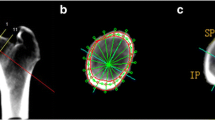Abstract
Summary
Structural geometric parameters at neck of the proximal femur were obtained using DXA-derived hip structural analysis (APEX 3) and quantitative computed tomography-derived (BIT QCT) techniques in 237 elderly females. Linear correlations for parameters ranged from 0.45 to 0.90. The average value of the subperiosteal width, as determined by the two techniques, was the same; variables dependent on mass measurements were different.
Introduction
There has been increasing interest in using bone structural geometry to assess bone fragility to complement bone mineral mass. The objective of this study is to compare structural geometrical differences between “2D” DXA-derived and “3D” QCT-derived techniques in unselected clinical cases.
Methods
All 237 females had both DXA and QCT assessments of femoral neck structural geometry. Variables compared were areal bone mineral density, cross-sectional area (CSA), cross-sectional moment of inertia (CSMI), section modulus (Z), averaged cortical thickness (Ct), endosteal width (ESW), subperiosteal width (W), and buckling ratio (BR).
Results
Correlation of femoral neck variables ranged from 0.45 for ESW to 0.90 for CSA. APEX 3 and BIT QCT-derived femoral neck W values were numerically similar. However CSA, CSMI, Z and Ct values measured by APEX 3 were higher and ESW and BR values were lower than corresponding BIT QCT.
Conclusions
2D DXA structural analysis of neck of femur is related to but different from same parameters calculated from true 3D images obtained by CT. Femoral neck size values are similar for DXA and QCT, but structural geometrical variables dependent on mass calibration standards, location of neck ROI and mathematical derivation techniques are different.


Similar content being viewed by others
References
Khoo BC, Brown K, Cann C, Zhu K, Henzell S, Low V, Gustafsson S, Price RI, Prince RL (2009) Comparison of QCT-derived and DXA-derived areal bone mineral density and T scores. Osteoporos Int 20:1539–1545
Martin RB, Burr DB (1984) Non-invasive measurement of long bone cross-sectional moment of inertia by photon absorptiometry. J Biomech 17:195–201
Nurzenski MK, Briffa NK, Price RI, Khoo BCC, Devine A, Beck TJ, Prince RL (2007) Geometric indices of bone strength are associated with physical activity and dietary calcium intake in healthy older women. J Bone Miner Res 22(3):416–424
Laskey MA, Price RI, Khoo BC, Prentice A (2011) Proximal femur structural geometry changes during and following lactation. Bone 48(4):755–759
Petit MA, McKay HA, MacKelvie KJ, Heinonen A, Khan KM, Beck TJ (2002) A randomized school-based jumping intervention confers site and maturity-specific benefits on bone structural properties in girls: a hip structural analysis study. J Bone Miner Res 17(3):363–372
Ramamurthi K, Ahmad O, Engelke K, Taylor RH, Zhu K, Gustafsson S, Prince RL, Wilson KE (2011) An in vivo comparison of hip structure analysis (HSA) with measurements obtained by QCT. Osteoporos Int. doi:10.1007/s00198-011-1578-1
Prince RL, Devine A, Dhaliwal SS, Dick IM (2006) Effects of calcium supplementation on clinical fracture and bone structure: results of a 5-year, double-blind, placebo-controlled trial in elderly women. Arch Intern Med 166(8):869–875
Beck TJ, Ruff CB, Warden KE, Scott WW Jr, Rao GU (1990) Predicting femoral neck strength from bone mineral data. A structural approach. Invest Radiol 25(1):6–18
Khoo BC, Beck TJ, Qiao QH, Parakh P, Semanick L, Prince RL, Singer KP, Price RI (2005) In vivo short-term precision of hip structure analysis variables in comparison with bone mineral density using paired dual-energy X-ray absorptiometry scans from multi-centre clinical trials. Bone 37(1):112–121
Khoo BCC, Wilson SG, Worth GK, Perks U, Qweitin E, Spector TD, Price RI (2009) A comparative study between corresponding structural geometrical variables using two commonly implemented hip structure analysis (HSA) algorithms applied to DXA images. J Clin Densitom 12(4):461–467
Prevrhal S, Shepherd JA, Faulkner KG, Gaither KW, Black DM, Lang TF (2008) Comparison of DXA hip structural analysis with volumetric QCT. J Clin Densitom 11(2):232–236
Ahmad O, Ramamurthi K, Wilson KE, Engelke K, Prince RL, Taylor RH (2010) Volumetric DXA (VXA): a new method to extract 3D information from multiple in vivo DXA images. J Bone Miner Res 25(12):2468–2475
Conflicts of interest
Dr Brown is a stockholder of Mindways Software Inc. Dr Wilson is an employee of Hologic Inc.
Author information
Authors and Affiliations
Corresponding author
Rights and permissions
About this article
Cite this article
Khoo, B.C.C., Brown, K., Zhu, K. et al. Differences in structural geometrical outcomes at the neck of the proximal femur using two-dimensional DXA-derived projection (APEX) and three-dimensional QCT-derived (BIT QCT) techniques. Osteoporos Int 23, 1393–1398 (2012). https://doi.org/10.1007/s00198-011-1727-6
Received:
Accepted:
Published:
Issue Date:
DOI: https://doi.org/10.1007/s00198-011-1727-6




